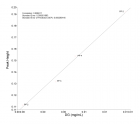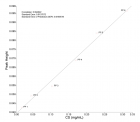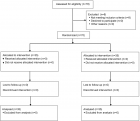Abstract
Research Article
Determination of anthocyanin content in two varieties of Hibiscus Sabdariffa from Selangor, Malaysia using a combination of chromatography and spectroscopy
Yew-Keong Choong*, Nor Syaidatul Akmal Mohd Yousof, Jamia Azdina Jamal and Mohd Isa Wasiman
Published: 30 July, 2019 | Volume 3 - Issue 2 | Pages: 067-075
The calyces of Hibiscus sabdariffa have been used by many communities as herbal tea. Their anthocyanin contents have been reported as the key component in anti-obesity studies. This present work reported results of anthocyanin content of calyces in two varieties of H. sabdariffa collected from Sabak Bernam, Selangor, Malaysia. The samples have been authenticated in the Herbarium, Institute of Bioscience, University Putra Malaysia prior to the study. The samples were processed and the ground dry raw material and its aqueous extract were analyzed using Fourier Transform Infrared (FTIR) and Two-Dimensional Infrared (2DIR). The short hybrid calyces (FT11-15A) raw material spectrum showed more than 80% similarity with long wild variety calyces (FT11-15B) when using “Compare” in analysis. The differences of both samples were obviously shown in their aqueous extract spectra. The peak at 1672 cm-1 and 841 cm-1 showed that tri-substituted double bond in FT11-15B aqueous extract was not present in FT11-15A aqueous extract spectra, whereby a double peak was assigned at 1221 cm-1 referred to anti symmetry stretching of aromatic and vinyl =C-O-C- with other =C-O- and 1192 cm-1 is assigned In-plane δ C-H in FT11-15A aqueous extract. The peak at 1071 cm-1 assigned as bonding C-H in plane bending of phenyl of both samples was the only peak comparable with standard delphinidin and cyanidin which are used for qualification and quantification of sample content. Aqueous extract spectra of both samples showed higher number of peaks detected compared with raw material spectra, which was attributed to the higher solubility of anthocyanins in water. The 2DIR correlation spectroscopy is advantageous in enhancing the qualitative analysis of herbal products. The anthocyanin content in both varieties of H. sabdariffa in descending amount is delphinidin-3-O-sambubioside (DS), cyanidin-3-O-sambubioside (CS), delphenidin-3-O-glucoside (DG) and lastly cyanidin-3-O-glucoside (CG). FT11-15A has more content of DS and DG of raw material and CG of water extract plus TFA than FT11-15B, whereby, FT11-15B has more content of CS, CG of raw material and DS, DG, CS of water extract plus TFA than FT11-15A.
Read Full Article HTML DOI: 10.29328/journal.jpsp.1001034 Cite this Article Read Full Article PDF
Keywords:
Hibiscus sabdariffa; Anthocyanins; Fourier transform infrared; Two - Dimensional infrared
References
- Mariod AA, Saeed Mirghani ME, Hussein I, Mariod AA, Saeed Mirghani ME, et al. Hibiscus sabdariffa L. Roselle. Unconventional Oilseeds and Oil Sources. 2017; 59-65.
- Riaz G, Chopra RA. review on phytochemistry and therapeutic uses of Hibiscus sabdariffa L. Biomedicine & Pharmacotherapy, 2018; 102: 575-586. PubMed: https://www.ncbi.nlm.nih.gov/pubmed/29597091
- Fallahi HR, Ramazani SHR, Ghorbany M, Aghhavani-Shajari, M. Path and factor analysis of roselle (Hibiscus sabdariffa L.) performance. Journal of Applied Research on Medicinal and Aromatic Plants. 2017; 6: 119-125.
- Cercato LM, White PAS, Nampo FK, Santos MRV, Camargo EA. A systematic review of medicinal plants used for weight loss in Brazil: Is there potential for obesity treatment? Journal of Ethnopharmacology. 2015; 176, 286-296. PubMed: https://www.ncbi.nlm.nih.gov/pubmed/26520790
- Hirunpanich V, Utaipat A, Morales NP, Bunyapraphatsara N, Sato H,et al. Hypocholesterolemic and antioxidant effects of aqueous extracts from the dried calyx of Hibiscus sabdariffa L. in hypercholesterolemic rats. Journal of Ethnopharmacology. 2006; 103, 252-260. PubMed: https://www.ncbi.nlm.nih.gov/pubmed/16213683
- Ojeda D, Jiménez-Ferrer E, Zamilpa A, Herrera-Arellano A, Tortoriello J, et al. Inhibition of angiotensin convertin enzyme (ACE) activity by the anthocyanins delphinidin- and cyanidin-3-O-sambubiosides from Hibiscus sabdariffa. Journal of Ethnopharmacology. 2010; 127: 7-10. PubMed: https://www.ncbi.nlm.nih.gov/pubmed/19808084
- Yang B, Liu H, Yang J, Gupta VK, Jiang Y. New insights on bioactivities and biosynthesis of flavonoid glycosides. Trends in Food Science & Technology. 2018; 79: 116-124.
- Zheoat AM, Gray AI, Igoli JO, Ferro VA, Drummond RM. Hibiscus acid from Hibiscus sabdariffa (Malvaceae) has a vasorelaxant effect on the rat aorta. Fitoterapia. 2019; 134: 5-13. PubMed: https://www.ncbi.nlm.nih.gov/pubmed/30690125
- Jackson RD, Isidore B, Cates RL. Are plant-soil dynamics different in pastures under organic management? A review. Agriculture, Ecosystems & Environment. 2019; 279: 53-57.
- Juhari NH, Bredie WLP, Toldam-Andersen TB, Petersen MA. Characterization of Roselle calyx from different geographical origins. Food Research International. 2018; 112, 378-389. PubMed: https://www.ncbi.nlm.nih.gov/pubmed/30131149
- Sharma HK, Sarkar M, Choudhary SB, Kumar AA, Maruthi RT, et al. Diversity analysis based on agro-morphological traits and microsatellite based markers in global germplasm collections of roselle (Hibiscus sabdariffa L.). Industrial Crops and Products. 2016; 89: 303-315.
- Osman Mohamad, Saberi S, Nezhadahmadi Arash, Faruq Golam. Development and Evaluation of Fruit Related Morphological and Physico-Chemical Characteristics in Three Roselle Mutants. Pakistan Journal of Nutrition. 2014; 13.
- Ma’arup R, Aziz MA, Osman M. Development of a procedure for production of haploid plants through microspore culture of roselle (Hibiscus sabdariffa L.). Scientia Horticulturae. 2012; 145: 52-61.
- Mahadevan N, Shivali A. and Kamboj P. Hibiscus sabdariffa Linn.-An overview. Natural Product Radiance. 2009; 8: 77-83. https://essentia.com.br/images/artigos/ativos-nov-2016/Tintura%20Hisbiscus.pdf
- Tham TC, Ng MX, Gan SH, Chua LS, Aziz R, et al. Impacts of different drying strategies on drying characteristics, the retention of bio-active ingredient and colour changes of dried Roselle. Chinese Journal of Chemical Engineering. 2018; 26: 303-316.
- Lu, Y., Wu, N., Fang, Y., Shaheen, N., & Wei, Y. An automatic on-line 2,2-diphenyl-1-picrylhydrazyl-high performance liquid chromatography method for high-throughput screening of antioxidants from natural products. Journal of Chromatography A. 2017; 1521: 100-109. PubMed: https://www.ncbi.nlm.nih.gov/pubmed/28939230
- Jiao L, Guo Y, Chen J, Zhao X, Dong D. Detecting volatile compounds in food by open-path Fourier-transform infrared spectroscopy. Food Research International. 2019; 119: 968-973. PubMed: https://www.ncbi.nlm.nih.gov/pubmed/30884737
- Smith MJ, Holmes-Smith AS, Lennard F. Development of non-destructive methodology using ATR-FTIR with PCA to differentiate between historical Pacific barkcloth. Journal of Cultural Heritage. 2019.
- Hua R, Sun SQ, ZhouQ, Noda I, Wang BQ. Discrimination of Fritillary according to geographical origin with Fourier transform infrared spectroscopy and two-dimensional correlation IR spectroscopy. Journal of Pharmaceutical and Biomedical Analysis. 2003; 33: 199-209. PubMed: https://www.ncbi.nlm.nih.gov/pubmed/12972085
- Zuo L, Sun S, Zhou Q, Tao J, Noda I. 2D-IR correlation analysis of deteriorative process of traditional Chinese medicine ‘Qing Kai Ling’ injection. Journal of Pharmaceutical and Biomedical Analysis. 2003; 30: 1491-1498. PubMed: https://www.ncbi.nlm.nih.gov/pubmed/12467920
Figures:

Figure 1

Figure 2

Figure 3

Figure 4

Figure 5

Figure 6

Figure 7

Figure 8
Similar Articles
-
Determination of anthocyanin content in two varieties of Hibiscus Sabdariffa from Selangor, Malaysia using a combination of chromatography and spectroscopyYew-Keong Choong*,Nor Syaidatul Akmal Mohd Yousof,Jamia Azdina Jamal,Mohd Isa Wasiman. Determination of anthocyanin content in two varieties of Hibiscus Sabdariffa from Selangor, Malaysia using a combination of chromatography and spectroscopy. . 2019 doi: 10.29328/journal.jpsp.1001034; 3: 067-075
Recently Viewed
-
Advances in Physiological Research: Consideration on Arterial Hypercapnia in Acute Cardiogenic Pulmonary Edema (ACPE)Andrea Bellone*. Advances in Physiological Research: Consideration on Arterial Hypercapnia in Acute Cardiogenic Pulmonary Edema (ACPE). Arch Case Rep. 2024: doi: 10.29328/journal.acr.1001108; 8: 116-117
-
Jaw Subluxation as a Complication of Tardive DyskinesiaDiana Paleacu Kertesz*. Jaw Subluxation as a Complication of Tardive Dyskinesia. Arch Case Rep. 2024: doi: 10.29328/journal.acr.1001112; 8: 131-133
-
Sleep Disorders and Sleep Studies Case ReportsAjay B Gadicha*,Vijay B Gadicha,Mayur S Burange,ZI Khan. Sleep Disorders and Sleep Studies Case Reports. Arch Case Rep. 2024: doi: 10.29328/journal.acr.1001114; 8: 146-151
-
Evaluation of Biostimulants Based on Recovered Protein Hydrolysates from Animal By-products as Plant Growth EnhancersH Pérez-Aguilar*, M Lacruz-Asaro, F Arán-Ais. Evaluation of Biostimulants Based on Recovered Protein Hydrolysates from Animal By-products as Plant Growth Enhancers. J Plant Sci Phytopathol. 2023: doi: 10.29328/journal.jpsp.1001104; 7: 042-047
-
Investigate the Effect of Coating Concentration and Coating Thickness on the Anti-microbial Properties of Polycarbonate SheetSaleh Alkarri. Investigate the Effect of Coating Concentration and Coating Thickness on the Anti-microbial Properties of Polycarbonate Sheet. Ann Biomed Sci Eng. 2024: doi: 10.29328/journal.abse.1001029; 8: 011-020
Most Viewed
-
Evaluation of Biostimulants Based on Recovered Protein Hydrolysates from Animal By-products as Plant Growth EnhancersH Pérez-Aguilar*, M Lacruz-Asaro, F Arán-Ais. Evaluation of Biostimulants Based on Recovered Protein Hydrolysates from Animal By-products as Plant Growth Enhancers. J Plant Sci Phytopathol. 2023 doi: 10.29328/journal.jpsp.1001104; 7: 042-047
-
Sinonasal Myxoma Extending into the Orbit in a 4-Year Old: A Case PresentationJulian A Purrinos*, Ramzi Younis. Sinonasal Myxoma Extending into the Orbit in a 4-Year Old: A Case Presentation. Arch Case Rep. 2024 doi: 10.29328/journal.acr.1001099; 8: 075-077
-
Feasibility study of magnetic sensing for detecting single-neuron action potentialsDenis Tonini,Kai Wu,Renata Saha,Jian-Ping Wang*. Feasibility study of magnetic sensing for detecting single-neuron action potentials. Ann Biomed Sci Eng. 2022 doi: 10.29328/journal.abse.1001018; 6: 019-029
-
Physical activity can change the physiological and psychological circumstances during COVID-19 pandemic: A narrative reviewKhashayar Maroufi*. Physical activity can change the physiological and psychological circumstances during COVID-19 pandemic: A narrative review. J Sports Med Ther. 2021 doi: 10.29328/journal.jsmt.1001051; 6: 001-007
-
Pediatric Dysgerminoma: Unveiling a Rare Ovarian TumorFaten Limaiem*, Khalil Saffar, Ahmed Halouani. Pediatric Dysgerminoma: Unveiling a Rare Ovarian Tumor. Arch Case Rep. 2024 doi: 10.29328/journal.acr.1001087; 8: 010-013

HSPI: We're glad you're here. Please click "create a new Query" if you are a new visitor to our website and need further information from us.
If you are already a member of our network and need to keep track of any developments regarding a question you have already submitted, click "take me to my Query."























































































































































